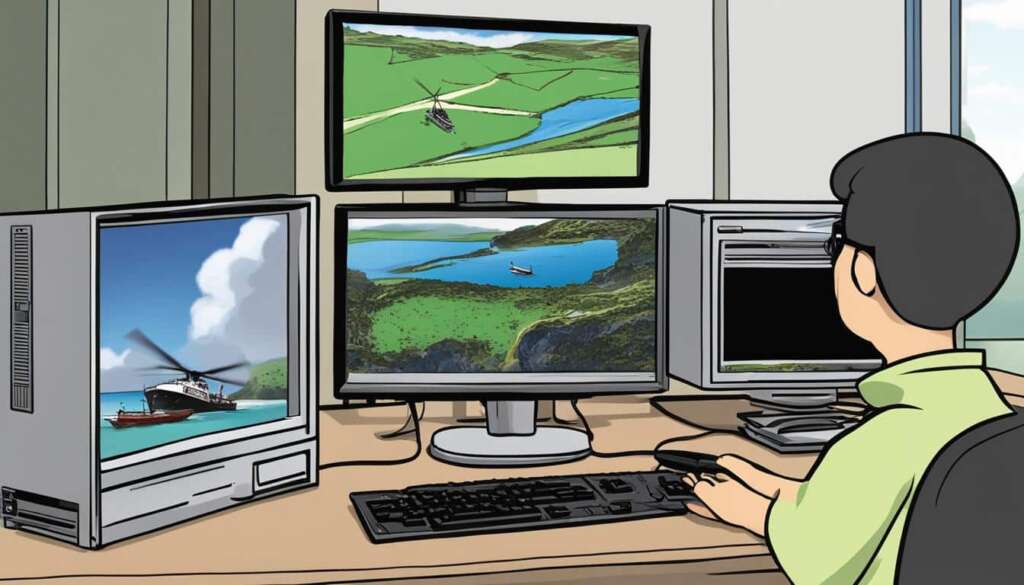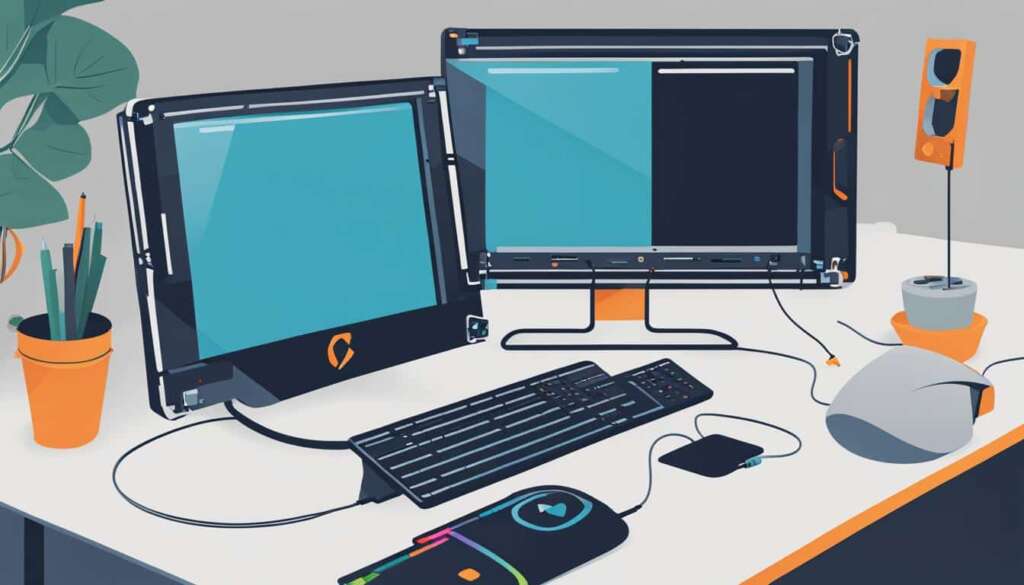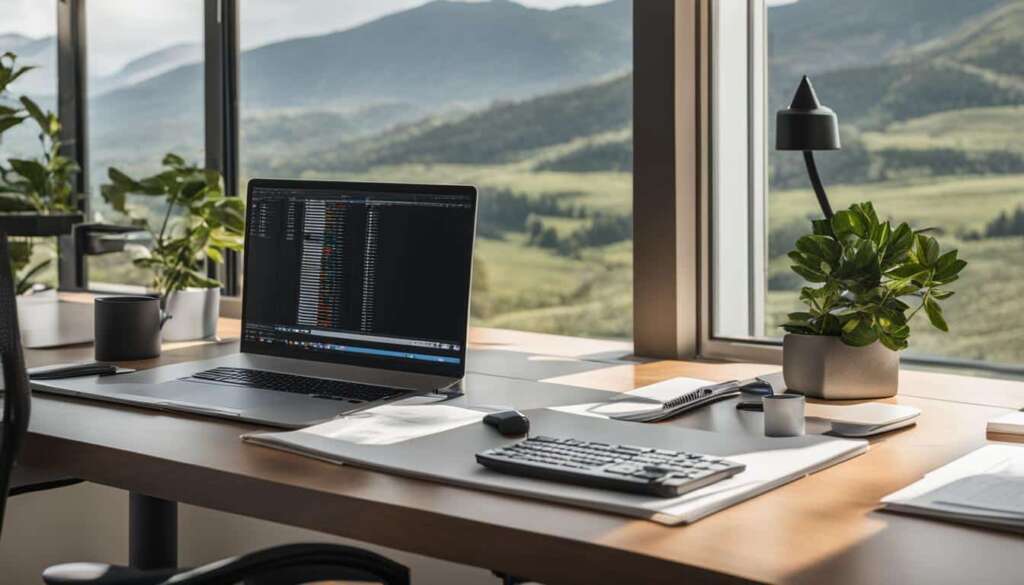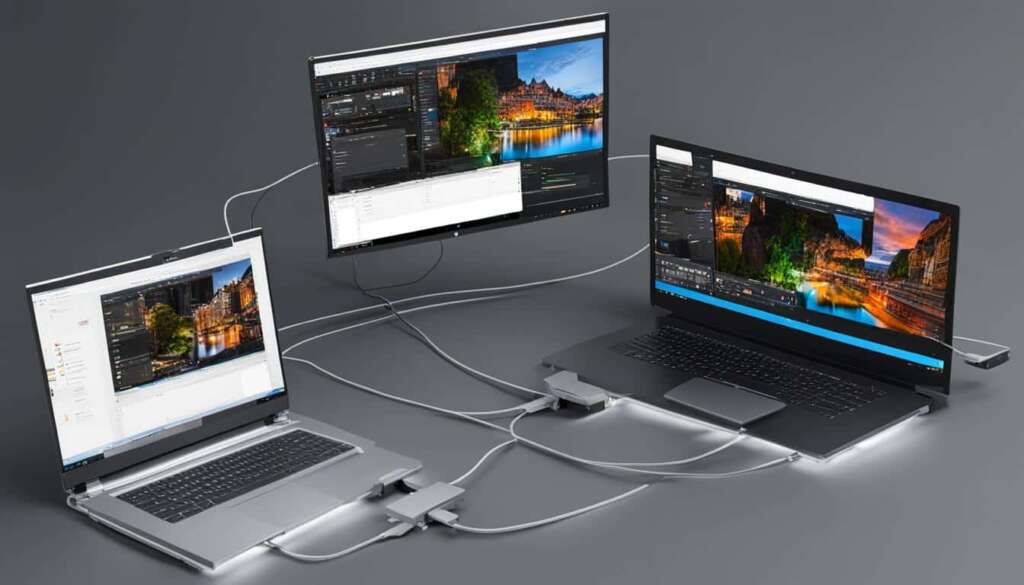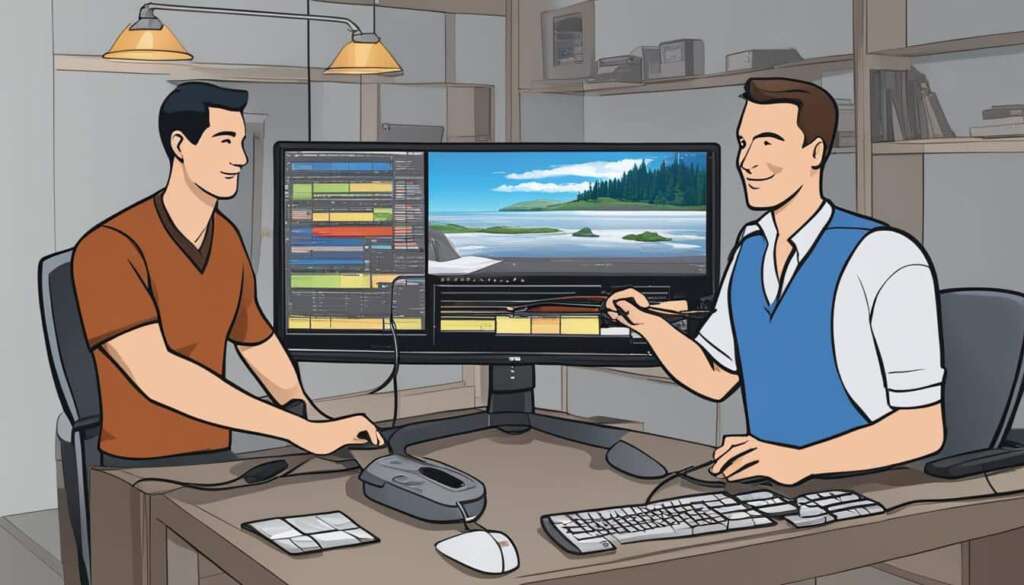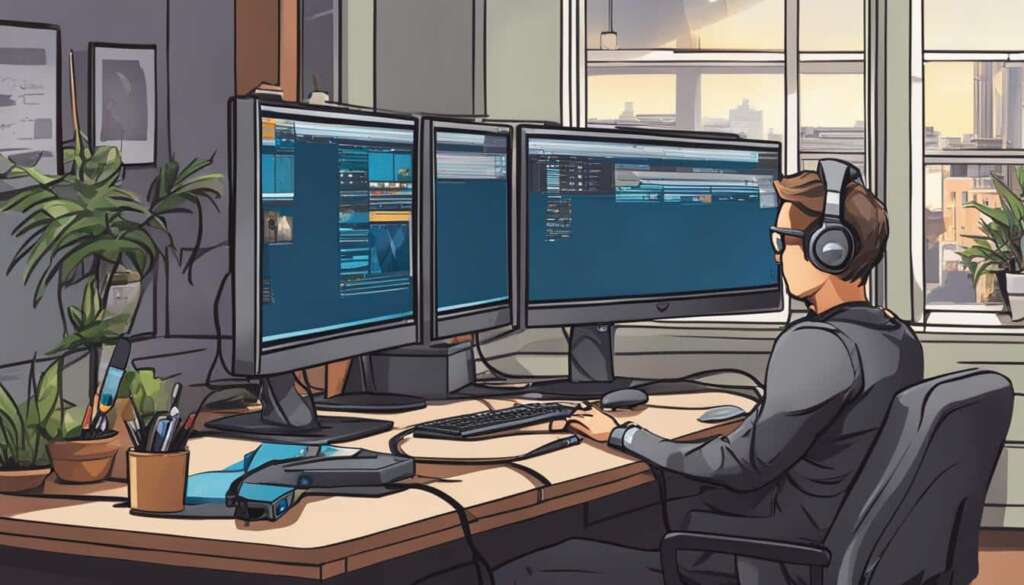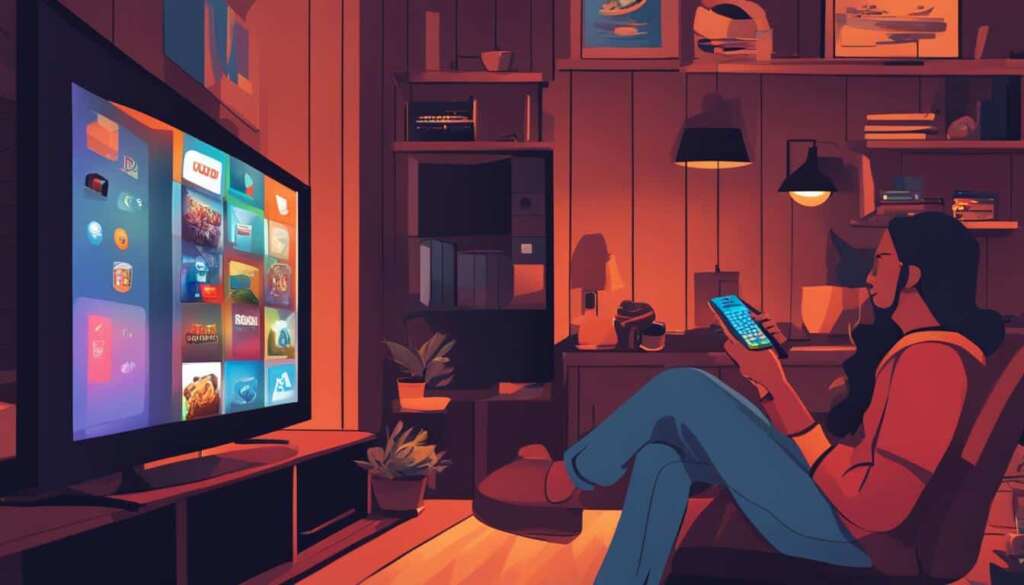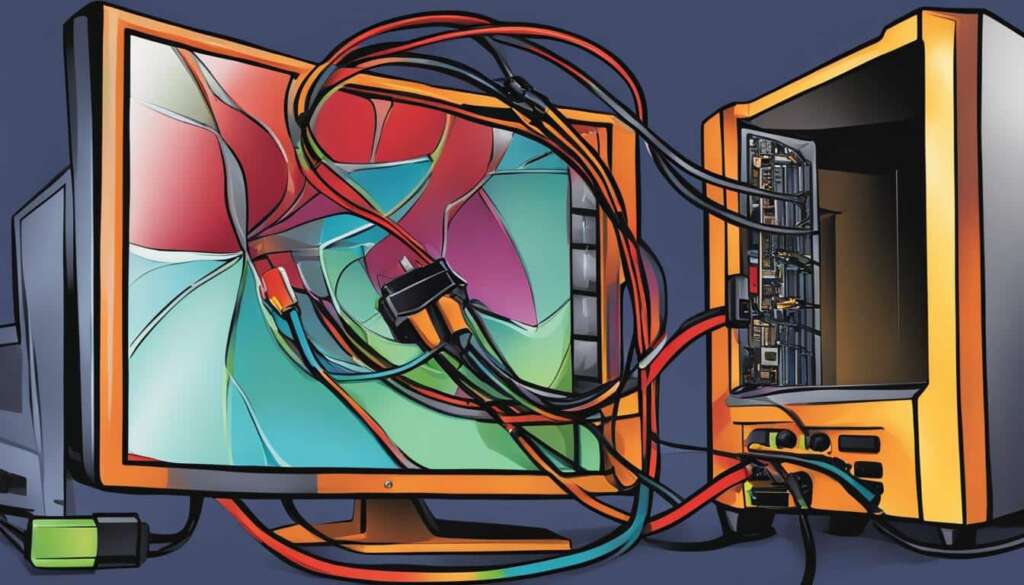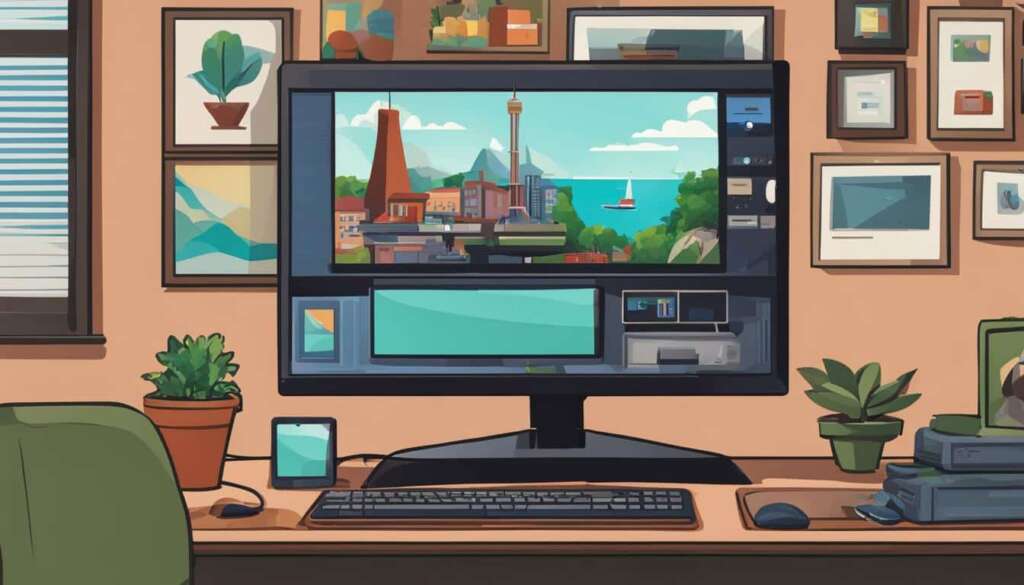Table of Contents
Connecting a monitor to a PC is a straightforward process that can greatly enhance your productivity and improve your viewing experience. By following a few simple steps, you can enjoy the benefits of a larger screen and better visual clarity while working or entertainment.
Before you start, it’s important to check the available ports on both your computer and monitor. Common connection ports include VGA, DVI, HDMI, Thunderbolt, USB-C, and DisplayPort. Once you have identified the ports, you can choose the appropriate cable or adapter to establish the connection.
It’s worth noting that different cables support different video and audio transmission capabilities. The most commonly used cables for monitor connections are VGA, DVI, HDMI, and DisplayPort, each offering varying levels of video quality and resolution. You may also need to consider if your monitor requires a separate power cable or if it can be powered directly through the video cable.
To connect the monitor to your PC, simply plug the cable into the corresponding ports on both devices. Then, power on both the computer and the monitor. Your computer will automatically detect the monitor, but you may need to adjust the display settings to optimize the arrangement of multiple monitors.
In conclusion, connecting a monitor to a PC is a simple and rewarding process. By following the steps outlined above, you can enjoy a larger and clearer display, improving your work efficiency and overall viewing experience.
Types of Video Connectors and Cables
When it comes to connecting a monitor to a PC, there are several types of video connectors and cables to consider. Each has its own features and compatibility specifications. Understanding the different options will help you choose the right connector and cable for your setup.
USB-C
The USB-C connector has gained popularity in recent years due to its versatility. It can transmit both digital audio and video signals simultaneously on a single cable, making it a convenient choice for connecting monitors to PCs. USB-C ports are commonly found on newer laptops and desktop computers.
DisplayPort
DisplayPort and mini-DisplayPort connectors are commonly used for digital audio and video transmission. They provide high-quality video signals and support multi-stream transport. Different versions of DisplayPort offer various enhancements, such as increased bandwidth and improved color depth.
HDMI
HDMI (High-Definition Multimedia Interface) is a popular connector for connecting monitors to PCs. It supports both video and audio signals, making it convenient for multimedia setups. HDMI cables come in different versions, with each offering different features such as high dynamic range (HDR) support and increased resolution capabilities.
DVI
DVI (Digital Visual Interface) connectors can transmit either analog or digital video signals. They are commonly found on older computers and monitors. DVI cables are still used for connecting older devices, although they are gradually being replaced by newer connectors.
VGA
VGA (Video Graphics Array) connectors are analog-only and have been widely used in the past. They are gradually being phased out in favor of digital connectors like HDMI and DisplayPort. VGA cables are still used to connect older monitors and computers that do not have digital video ports.
Other Connectors
There are also other types of connectors that are used for analog video transmission. These include component video, RCA (composite), and S-video connectors. These connectors are often used to connect devices like TVs and projectors that do not have digital video ports.
It is important to identify the type of video connector available on your computer and monitor to ensure compatibility. Using the correct video cable or adapter will help avoid video or display issues and optimize the quality of your viewing experience.
Check out the table below for a comparison of different video connectors and their features:
| Connector | Digital or Analog | Audio Support | Resolution Support | Common Uses |
|---|---|---|---|---|
| USB-C | Digital | Yes | Up to 8K | Laptops, desktop computers |
| DisplayPort | Digital | Yes | Up to 8K | Laptops, desktop computers, monitors |
| HDMI | Digital | Yes | Up to 8K | Laptops, desktop computers, TVs, multimedia setups |
| DVI | Both (Analog or Digital) | No | Up to 2560×1600 | Older computers, monitors |
| VGA | Analog | No | Up to 1920×1080 | Older computers, monitors |
| Component Video | Analog | No | Depends on device | TVs, projectors |
| RCA (Composite) | Analog | No | Depends on device | TVs, projectors |
| S-video | Analog | No | Depends on device | TVs, projectors |
Steps to Connect a Monitor to a PC
Connecting a monitor to your PC is a straightforward process that can greatly enhance your computing experience. Follow these simple steps to set up your monitor:
- Check the available ports: Before you begin, identify the ports on your computer and monitor to ensure compatibility. Common connection ports include VGA, DVI, HDMI, Thunderbolt, USB-C, and DisplayPort.
- Choose the appropriate cable: Once you have determined the ports, select the corresponding cable or adapter to establish the connection. Remember that different cables support different video and audio transmission capabilities.
- Power on the devices: Some monitors require a separate power cable, while others can be powered through the video cable. Connect the cable to the respective ports on your computer and monitor, and then power on both devices.
- Adjust display settings: After connecting the monitor, your computer will automatically detect it. However, you may need to adjust the display settings to optimize the arrangement of multiple monitors or adjust the screen resolution as needed.
Pro Tip: If you encounter any issues with the connection, double-check that the cables are securely plugged in and that the correct input source is selected on the monitor.
Now you’re ready to enjoy the expanded screen real estate and improved productivity that a second monitor brings!
For a visual representation, refer to the table below:
| Computer Port | Monitor Port | Cable/Adapter |
|---|---|---|
| VGA | VGA | VGA cable |
| DVI | DVI | DVI cable |
| HDMI | HDMI | HDMI cable |
| DisplayPort | DisplayPort | DisplayPort cable |
| USB-C or Thunderbolt | DisplayPort, HDMI, or USB-C | USB-C to DisplayPort, HDMI, or USB-C cable/adapter |
Tips for Choosing the Right Cable and Troubleshooting
When connecting your monitor to a PC, choosing the right cable is essential for a seamless experience. Consider factors such as the available ports on your computer and monitor, the desired video and audio capabilities, and the display resolution you want to achieve.
HDMI cables are generally recommended for their versatility and high-definition video and audio transmission. They offer excellent compatibility with modern monitors and support advanced features like 4K resolution and HDR. However, if you need to connect older devices with VGA or DVI ports, don’t worry. You can use appropriate adapters or converters to ensure compatibility.
In case you encounter any issues with your monitor connection, troubleshooting is the key. Start by checking all the cable connections to ensure they are secure and properly inserted. If the monitor is not displaying anything, verify that the power is on and the correct input source is selected on the monitor.
If you are experiencing video resolution issues, double-check the display settings on your computer. Adjust the resolution to match the capabilities of your monitor, and consider updating your graphics driver for optimal performance. It’s also worth checking if there are any firmware updates available for your monitor, as they can sometimes resolve compatibility or performance issues.
FAQ
How do I connect a monitor to a PC?
Connecting a monitor to a PC is a simple process. First, check the available ports on your computer and monitor to ensure compatibility. Common connection ports include VGA, DVI, HDMI, Thunderbolt, USB-C, and DisplayPort. Once you have identified the ports, choose the appropriate cable or adapter to make the connection. Plug the cable into the corresponding ports on your computer and monitor, and then power on both devices. The computer will automatically detect the monitor, but you may need to adjust the display settings for multiple monitors.
What are the different types of video connectors and cables?
There are several types of video connectors and cables that can be used to connect a monitor to a PC. These include USB-C, DisplayPort, HDMI, DVI, VGA, component video, RCA (composite), and S-video. Each connector has different capabilities and is used for specific purposes. USB-C is versatile and can transmit digital audio and video signals on a single cable. DisplayPort and HDMI are commonly used for digital audio and video transmission, with different versions offering enhanced features. DVI connectors can transmit analog or digital signals, while VGA connectors are analog-only. Other connectors like component video, RCA, and S-video are used for analog video transmission to TVs or projectors.
What are the steps to connect a monitor to a PC?
To connect a monitor to your PC, follow these steps:
1. Check the ports on your computer and monitor for compatibility.
2. Choose the appropriate cable or adapter based on the ports.
3. Plug one end of the cable into the corresponding port on your computer.
4. Plug the other end of the cable into the corresponding port on your monitor.
5. Power on both your computer and monitor.
6. Adjust the display settings if necessary to optimize the arrangement of multiple monitors.
How do I choose the right cable for my monitor connection?
When choosing a cable for your monitor connection, consider factors such as the available ports on your computer and monitor, desired video and audio capabilities, and the display resolution you want to achieve. HDMI cables are generally recommended for their versatility and support for high-definition video and audio transmission. If you need to connect older devices with VGA or DVI ports, you can use appropriate adapters or converters to ensure compatibility.
What do I do if I encounter video resolution issues or other problems with my monitor connection?
If you experience video resolution issues or encounter problems with your monitor connection, here are a few troubleshooting tips:
– Check that the cable is securely connected to both the computer and monitor.
– Ensure that the correct input source is selected on the monitor.
– Update your graphics driver to the latest version.
– Try using a different cable or adapter to rule out any compatibility issues.
– Adjust the display settings on your computer to match the resolution and refresh rate supported by your monitor.
If the problem persists, consult the user manual or contact the manufacturer for further assistance.

